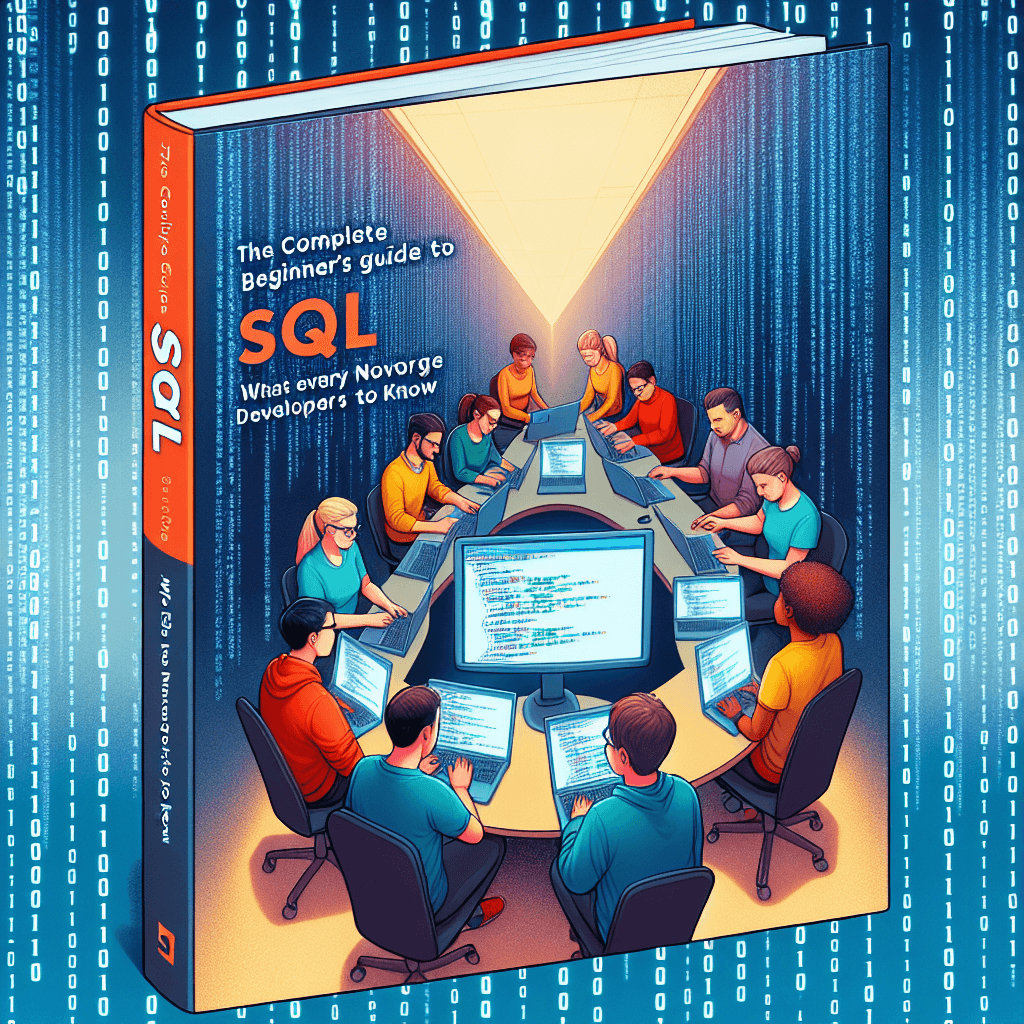A big variety of articles and resources

10 Essential Tips for the Novice Data Analyst: Jumpstarting Your Analytics Career
 Sia Author and Instructor
Learn SQL
Sia Author and Instructor
Learn SQL
12 minute read
1. Introduction to SQL
Structured Query Language, or SQL, is the cornerstone of data manipulation and analysis. Mastering SQL is essential for anyone aspiring to become a proficient data analyst. It allows you to interact with databases, extract relevant information, and make data-driven decisions.
Why Learn SQL?
- It's the standard language for relational database management.
- SQL skills are in high demand across various industries.
- It provides the foundation for understanding more complex data systems.
SQL is not just about writing queries; it's about understanding how data is interconnected and how to retrieve it in the most efficient way possible.
As you embark on your journey to becoming a data analyst, remember that SQL is more than a technical skill—it's a way to unlock the potential of data and derive meaningful insights that can inform business strategies. Start with the basics, practice regularly, and soon you'll be crafting complex queries with confidence.
2. SQL Query Crafting
Mastering SQL query crafting is a pivotal skill for any data analyst. Crafting efficient and accurate SQL queries is not just about understanding the syntax; it's about developing a mindset to interrogate data in ways that yield meaningful insights. Start with the basics: SELECT, FROM, WHERE, and JOIN clauses, and progressively incorporate more complex structures like subqueries and CTEs (Common Table Expressions).
- SELECT: Retrieve data from one or more tables.
- FROM: Specify the table to query data from.
- WHERE: Filter data based on conditions.
- JOIN: Combine rows from two or more tables.
As you advance, focus on optimizing your queries for performance and readability. Remember, a well-crafted query not only fetches the correct data but does so efficiently.
Embrace the iterative process of query optimization. Test different approaches, analyze execution plans, and refine your queries to minimize resource usage while maximizing speed and accuracy.
Whether you're analyzing sales data, customer behavior, or operational metrics, the ability to construct and refine SQL queries will empower you to extract valuable insights from vast datasets. This skill is the cornerstone of data analysis and will serve as a foundation for all your future analytics endeavors.
3. Advanced Reporting Skills
Developing advanced reporting skills is crucial for a data analyst to effectively communicate insights. Mastering the art of data visualization is key; it transforms complex data sets into clear and actionable information. A strong grasp of tools like Microsoft Office Suite and statistical software enhances your ability to create compelling reports.
Advanced reporting goes beyond mere numbers; it involves interpreting data to tell a story that drives business decisions.
To excel in reporting, focus on the following areas:
- Synthesizing technical information
- Applying critical thinking to data analysis
- Authoring peer-reviewed publications
- Delivering presentations and crafting technical documents
Remember, the goal is to represent complex data in a manner that is both accessible and informative. Your reports should not only be accurate but also engaging, ensuring they capture the attention of your audience and effectively support decision-making processes.
4. Data-Driven Decision Making
In the realm of data analytics, data-driven decision making stands as a pivotal skill. It involves the use of data to guide strategic business decisions, ensuring that intuition is complemented by hard evidence. To excel in this area, a novice data analyst must understand not only how to interpret data but also how to communicate findings effectively to stakeholders.
Embrace a culture of analytics where data is the cornerstone of decision-making processes. This approach fosters an environment where every decision is backed by quantitative support, minimizing guesswork and maximizing strategic outcomes.
Key components of data-driven decision making include:
- Identifying relevant data sources
- Collecting high-quality, accurate data
- Analyzing data to uncover trends and insights
- Presenting data in a clear, understandable manner
One must not overlook the importance of collaboration in this process. Engaging with various departments and understanding their unique needs can lead to more comprehensive and impactful analytics. Remember, the goal is to empower your organization with actionable insights that drive success.
5. Career Advancement
As a novice data analyst, networking is a pivotal step in your career advancement. It's not just about who you know; it's about who knows what you can do. Be clear about your career aspirations when interacting with your network. For instance, instead of a broad statement like "I want to use my skills at a company," specify the type of role and industry you're targeting.
Engage in continuous learning and skill enhancement to stay competitive in the field of data analysis. This could involve taking specialized courses, attending workshops, or participating in webinars.
Here are some practical steps to consider for career growth:
- Identify your career goals and the skills required to achieve them.
- Seek out mentorship and guidance from experienced professionals.
- Attend industry conferences and networking events.
- Stay updated with the latest industry trends and technologies.
- Actively contribute to data analysis forums and online communities.
Remember, every interaction is an opportunity to learn and grow. Your commitment to professional development and your ability to articulate your value proposition can significantly influence your career trajectory.
6. Real-World Application
Applying SQL skills to real-world scenarios is a critical step in becoming a proficient data analyst. Practical learning through hands-on projects allows you to understand and solve actual problems with tangible stakes. Engaging in exercises that reflect everyday analytical challenges not only solidifies your SQL knowledge but also prepares you for the dynamic nature of data analysis in a professional setting.
Experience gathering and analyzing data is essential for making informed decisions. By tackling real-world problems, you gain a deeper understanding of the day-to-day workings within the field, including both the perks and the challenges. This experience is invaluable for personal and professional growth.
By immersing yourself in practical applications, you enhance your ability to handle diverse situations and requirements effectively.
Here's a glimpse of what you can expect from real-world application exercises:
- Solve case studies based on actual business scenarios.
- Implement SQL queries to navigate complex datasets.
- Analyze data to inform marketing strategies and business decisions.
- Participate in projects that simulate the demands of data-driven roles.
These activities are designed to bridge the gap between theoretical knowledge and practical expertise, making you a valuable asset in any data-driven role.
7. SQL Data Manipulation Tools
Mastering SQL data manipulation tools is essential for any data analyst looking to refine their craft. These tools enable you to efficiently clean, transform, and analyze your datasets, which is crucial for deriving actionable insights. Understanding and utilizing these tools can significantly enhance your data analysis capabilities.
When working with SQL, you'll encounter a variety of data manipulation tools, each with its specific use cases. Here's a brief overview of some key tools:
- GROUP BY: Used for aggregating data based on specified columns.
- HAVING: Allows filtering on aggregated data, similar to WHERE but for groups.
- UNION/UNION ALL: Combines results from multiple SELECT queries.
- JOINs (INNER, LEFT, RIGHT, FULL): Essential for combining rows from two or more tables.
It's important to not only learn these tools but to practice applying them in real-world scenarios. This hands-on experience will prepare you for the complexities of data analysis projects.
As you progress, you'll find that some tools are more suited to certain tasks than others. For instance, JOINs are invaluable when you need to correlate data from different tables, while GROUP BY is your go-to for summarizing data. Balancing theoretical knowledge with practical application is key to becoming proficient in SQL data manipulation.
8. Complex Data Handling
As a novice data analyst, mastering complex data handling is crucial for extracting meaningful insights from large and intricate datasets. This involves not only understanding advanced SQL functions and techniques but also being able to apply statistical methods and computational mathematics to analyze and interpret data effectively.
Advanced capabilities in data analysis and visualization are essential. Familiarity with tools such as Microsoft Excel, SQL data manipulation tools, and statistical software like JMP or Graphpad Prism can significantly enhance your analytical prowess. Here's a brief overview of skills that can elevate your data handling abilities:
- Profound knowledge of different programming languages (Python, R, SQL, etc.)
- Strong foundation in data structures and algorithms
- Knowledge of machine learning algorithms and libraries
- Software design and architecture
By honing these skills, you position yourself to tackle real-world problems with confidence and contribute to data-driven decision-making processes.
Remember, complex data handling is not just about managing data; it's about transforming it into actionable insights that can inform strategic decisions. Continuous learning and staying abreast of emerging practices in the field will ensure that your skills remain relevant and powerful.
9. SQL Functions and Techniques
Mastering SQL functions and techniques is crucial for any data analyst looking to extract meaningful insights from data. Understanding and utilizing functions like COUNT, SUM, and AVG can transform raw data into actionable information. Learning to use these functions efficiently is key to performing complex data analysis tasks.
Italics are often used to emphasize SQL keywords or functions, such as JOIN, GROUP BY, or ORDER BY, which are essential in organizing and retrieving data in specific ways. Familiarity with these commands allows analysts to manipulate data sets with precision.
Advanced SQL techniques involve subqueries, window functions, and CTEs (Common Table Expressions). These tools enable analysts to perform sophisticated operations on data sets, such as partitioning data or creating temporary result sets for further analysis.
Here's a quick reference for some common SQL aggregate functions:
| Function | Description |
|---|---|
| COUNT | Counts the number of rows |
| SUM | Adds together all values in a column |
| AVG | Calculates the average of values |
| MAX | Finds the maximum value |
| MIN | Finds the minimum value |
By integrating these functions into your SQL queries, you can enhance your analytical capabilities and provide deeper insights into your data. Continuous practice and application of these techniques will solidify your understanding and help you become a proficient data analyst.
10. Foundation for Future Learning
As a novice data analyst, laying a strong foundation for future learning is crucial. Begin with a solid understanding of database concepts, as this knowledge is essential for advancing to more complex SQL topics and database design.
Quickly grasp the essentials through courses designed to be concise and straightforward. This approach is ideal for those eager to learn efficiently without getting overwhelmed by technical jargon.
Embrace the journey of continuous learning. The field of data analytics is ever-evolving, and staying updated with the latest tools and techniques is key to career growth.
Here's a snapshot of the skills you'll develop as you progress:
- Fundamental database concepts
- SQL querying and data manipulation
- Advanced reporting and analytical techniques
- Application of SQL in real-world scenarios
Remember, each step you take builds upon the last, preparing you for the complexities of data analysis and the exciting challenges it presents. With dedication and the right resources, you'll not only learn SQL but also how to apply it effectively in various professional scenarios, enhancing your analytical capabilities and making you a valuable asset in any data-driven role.
Embark on a journey of continuous growth and skill enhancement with our expertly crafted courses at EzySkills. Chapter 10, 'Foundation for Future Learning,' is just the beginning. Dive into our course catalogue and discover the perfect course to elevate your technical prowess. Don't wait to transform your career; visit our website now and sign up to start learning today!
Conclusion
As we wrap up our journey through the essential tips for novice data analysts, remember that the field of data analytics is dynamic and ever-evolving. The key to jumpstarting your analytics career lies in continuous learning and practical application of your skills. Embrace the challenges and opportunities presented by real-world data, and don't hesitate to leverage courses and resources to enhance your SQL proficiency and analytical capabilities. With dedication and the right approach, you can transform data into actionable insights and become a valuable asset in any data-driven role. Keep exploring, practicing, and staying updated with industry trends to ensure your growth in this exciting and rewarding career path.
Frequently Asked Questions
What is SQL and why is it important for data analysts?
SQL, or Structured Query Language, is a programming language designed for managing and querying relational databases. It's crucial for data analysts as it allows them to retrieve, manipulate, and analyze data stored in databases, which is essential for making data-driven decisions.
Can I start a career in data analysis with just SQL knowledge?
While SQL is a fundamental skill for data analysts, a successful career in data analysis typically requires additional skills, such as data visualization, statistical analysis, and knowledge of data analysis tools. However, SQL is a strong foundation and often a prerequisite for further learning and career advancement.
How long does it typically take to become proficient in SQL?
The time it takes to become proficient in SQL can vary depending on the individual's learning pace, prior experience, and the complexity of the SQL concepts being learned. With consistent practice and real-world application, many learners can achieve a working knowledge of SQL within a few weeks to a few months.
Are there specific industries where SQL skills are particularly valuable?
SQL skills are valuable across a wide range of industries, including finance, healthcare, technology, retail, and any other sectors that rely on data storage and analysis. Proficiency in SQL is beneficial for roles in data analysis, business intelligence, database administration, and more.
What are some common challenges beginners face when learning SQL?
Beginners often face challenges such as understanding complex queries, optimizing query performance, dealing with different database systems, and learning how to structure data effectively. Overcoming these challenges requires practice, patience, and sometimes guidance from more experienced users or instructors.
How can I practice my SQL skills in a real-world context?
To practice SQL skills in a real-world context, you can work on projects that involve querying real datasets, participate in SQL challenges or hackathons, contribute to open-source projects, or use online platforms that provide practical SQL exercises and simulations of real-world problems.




